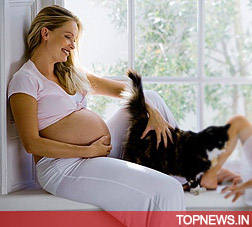 During the entire 9 months of pregnancy, expectant mothers receive a constant influx of information regarding what they should and shouldn’t do in order to protect and care for their unborn child. They keep lists of what they can and cannot eat. They avoid caffeinated beverages, and abstain from the majority of pharmaceuticals. They regularly elevate their legs, rearrange their entire schedules around doctor appointments, and even overly concern themselves with the temperature of their bath water. In the midst of all these concerns arises the question regarding cats. Should they keep their beloved feline? Should they avoid cats in general?
During the entire 9 months of pregnancy, expectant mothers receive a constant influx of information regarding what they should and shouldn’t do in order to protect and care for their unborn child. They keep lists of what they can and cannot eat. They avoid caffeinated beverages, and abstain from the majority of pharmaceuticals. They regularly elevate their legs, rearrange their entire schedules around doctor appointments, and even overly concern themselves with the temperature of their bath water. In the midst of all these concerns arises the question regarding cats. Should they keep their beloved feline? Should they avoid cats in general?The primary risks involve potential parasitic infections that may harm the unborn baby. The most common concern is the chance that the expectant mother may contract a toxoplasmosis infection. A parasitic organism by the name of Toxoplasma gondii is responsible for the problem. This organism can cause serious harm to a developing fetus during its first trimester (such as congenital defects). Cats may come in contact with these toxoplasmosis-causing parasites if they ingest wildlife that has already been contaminated with the parasites. The T. gondii parasite relies upon the cat for its life cycle. It can live quite comfortably in a cat’s digestive tract, passing on its eggs through the cat’s feces.
It important to understand that the only way a cat can pass on the parasitic organisms is through its feces. In order to become infected, a pregnant woman must swallow a parasite or parasite egg.
 For this reason, it is strongly recommended that an expectant mother not handle cat litter. If she must do so, she should wear rubber gloves and follow extra hygiene precautions. Cat feces must be incinerated or flushed daily. To minimize risk of infection, it is essential that the cat be kept away from kitchen counters and tabletops. Pregnant women should also wash their hands after spending time with their pet cat. Cats should also be taken to their local veterinarian to make sure that their worming and vaccination schedules are up to date.
For this reason, it is strongly recommended that an expectant mother not handle cat litter. If she must do so, she should wear rubber gloves and follow extra hygiene precautions. Cat feces must be incinerated or flushed daily. To minimize risk of infection, it is essential that the cat be kept away from kitchen counters and tabletops. Pregnant women should also wash their hands after spending time with their pet cat. Cats should also be taken to their local veterinarian to make sure that their worming and vaccination schedules are up to date.
Interestingly enough, cats are not the sole source of toxoplasmosis. Eating either undercooked meat, or foods grown in soil contaminated with the parasites, also places pregnant women at risk. For this reason, it is recommended that pregnant women thoroughly wash all fruits and vegetables, and not drink unpasteurized milk. As a further precaution, pregnant women should wear gloves when gardening.
Of course, proper precautions must be taken, but it is possible for both cats and pregnant women to coexist safely in the same home.


No comments:
Post a Comment